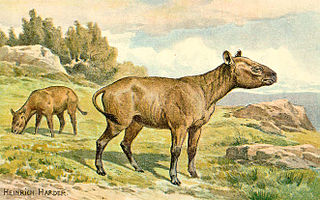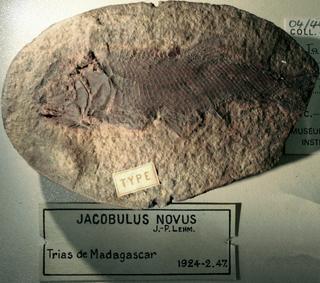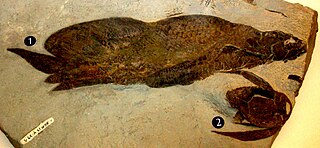
Epihippus is an extinct genus of the modern horse family Equidae that lived in the Eocene, from 46 to 38 million years ago.

The Hyracodontidae are an extinct family of rhinocerotoids endemic to North America, Europe, and Asia during the Eocene through early Oligocene, living from 48.6 to 26.3 million years ago (Mya), existing about 22.3 million years.

Euryzygoma is an extinct genus of marsupial which inhabited humid eucalyptus forests in Queensland and New South Wales during the Pliocene of Australia. Euryzygoma is believed to have weighed around 500 kg, and differed from other diprotodonts in having unusual, flaring cheekbones that may have been used either for storing food or for sexual display. Euryzygoma is thought to be the ancestral genus from which Diprotodon evolved.
Fleurantia is a genus of prehistoric lungfish which lived during the Devonian period. Fossils have been found in North America.

Jacobulus is an extinct genus of prehistoric ray-finned fish that lived during the Early Triassic epoch in what is now northern Madagascar 252.3 to 251.3 million years ago. The type species is Jacobulus novus (monotypy). It was a small fish less than 10 centimetres (3.9 in) in length. J. novus ecology was a grazer-detritivore. It belongs to the Parasemionotidae together with Albertonia, Candelarialepis, Icarealcyon, Lehmanotus, Parasemionotus, Qingshania, Stensioenotus, Suius, Thomasinotus, and Watsonulus.
The Laventan age is a period of geologic time within the Middle Miocene epoch of the Neogene, used more specifically within the SALMA classification in South America. It follows the Colloncuran and precedes the Mayoan age.

Scaumenacia is an extinct genus of lungfish. It lived around the Devonian in North America alongside another prehistoric lungfish: Fleurantia. It lived from approximately 384 to 376 millions of years ago.

Chelonoidis is a genus of turtles in the tortoise family erected by Leopold Fitzinger in 1835. They are found in South America and the Galápagos Islands, and formerly had a wide distribution in the West Indies.

Baenidae is an extinct family of paracryptodiran turtles known from the Early Cretaceous to Eocene of North America. While during the Early Cretaceous they are found across North America, during the Late Cretaceous they are only found in Laramidia, having disappeared from Appalachia. The majority of lineages survived the K-Pg Extinction, but the family was extinct by the latest Eocene. The name of the type genus, Baena, appears to be of Native American origin, likely from the Arapaho be’enoo. They are primarily found in freshwater deposits, and are considered to be aquatic, with a largely generalist habit.
The Kokoamu Greensand is a geological formation found in New Zealand. It is a fossil-bearing, late Oligocene, greensand rock unit of the eastern South Island, especially the Waitaki District of North Otago and the southern Canterbury region. The formation was named by geologist Maxwell Gage in the 1950s. In North Otago it underlies the thicker and harder Otekaike Limestone. The formation gets its green colour from the mineral glauconite which forms slowly on the ocean floor.

Leptadapis is a genus of adapiform primate that lived in Europe during the middle Eocene. Fossils of the genus have been found in the Escanilla Formation of Spain and Egerkingen in Switzerland.

Hippohyini was an extinct tribe of Suinae which existed in Asia during the Pliocene.

Hyotheriinae was a subfamily of even-toed ungulates that existed during the Miocene and Pliocene in Europe, Asia, and Africa.

Boreostemma is an extinct genus of glyptodonts from northern South America. Fossils assigned to the genus were first described as belonging to Asterostemma from southern South America, but have been placed in the new genus Boreostemma by Carlini et al. in 2008. The type species is B. pliocena. Fossils of Boreostemma have been found in the Honda Group of Colombia, in Peru and Venezuela.

Miocochilius is an extinct genus of small notoungulate mammals (typotheres) native to South America. The genus lived during the Middle Miocene epoch. The genus contains two described species, the type species M. anomopodus described in 1953 by Ruben Arthur Stirton and M. federicoi, described and included in the genus by Darin A. Croft.

Thanatosdrakon is a genus of quetzalcoatline azhdarchid pterosaur from the Late Cretaceous Plottier Formation of the Neuquén Basin in western Argentina. The genus name is derived from the Greek words thanatos (=death) and drakon (=dragon), while the specific name is a Quechuan word meaning "flying serpent" and refers to the Incan deity Amaru. The type and only species is Thanatosdrakon amaru, known from two specimens consisting of several well-preserved axial and appendicular bones including material previously undescribed in giant azhdarchids. Thanatosdrakon is one of the oldest known members of the Quetzalcoatlinae. T. amaru lived from about 90 to 86 million years ago.

Australobatrachia is a clade of frogs in the suborder Neobatrachia. It comprises three families of frogs with a Gondwanan distribution, being known from Chile, Australia, and New Guinea. Together, they form the sister group to the superfamily Hyloidea.
Jurassonurus is an extinct insect genus of mayflies (Ephemeroptera). This genus has only one member and that member has been scientifically named Jurassonurus amoenus which lived during the Middle Jurassic period 164.7 million to 155.7 million years ago in the Jiulongshan formation, Daohugou Village, Shantou Township, Ningcheng country, Inner mongolia, China.
Georgiomeryx is an extinct genus of mammal in the giraffid clade that lived during the late Miocene epoch in the areas of Greece and Spain about 15.97 million to 11.608 million years ago. The only species in this genus is Georgiomeryx georglasi.
Panolax is an extinct genus of North American Leporid mammal that lived during the Cenozoic era during the Neogene period in the Miocene epoch, about 13.6 million to 10.3 million years ago. The genus has one sole species which is Panolax sanctaefidei. The species lives in North America and only been found in the United States, specifically California and New Mexico. P. scanctaefidei feed on insects species making it a insectivore, an organism that has a diet of primarily insects, arthropods and other similar species.














